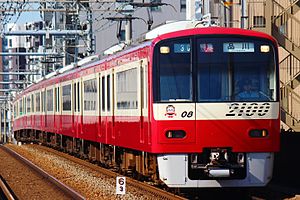Keikyu 2100 series
| Keikyu 2100 series | |
|---|---|

Set 2101 in July 2014
|
|
| Manufacturer | (Kobe) and Tokyu Car (Yokohama) |
| Replaced | Keikyu 2000 series |
| Entered service | 28 March 1998 |
| Refurbishment | 2013– |
| Number built | 80 vehicles (10 sets) |
| Formation | 8 cars per trainset |
| Capacity | 942 passengers |
| Operator(s) | Keikyu |
| Specifications | |
| Car body construction | Aluminium |
| Car length | 18,000 mm (59 ft 1 in) (intermediate cars) 18,170 mm (59 ft 7 in) (end cars |
| Width | 2,830 mm (9 ft 3 in) |
| Maximum speed | 120 km/h (75 mph) |
| Traction system | Original: GTO-VVVF (Siemens) Current: IGBT-VVVF (Toyo Denki) |
| Acceleration | 3.5 km/h/s |
| Deceleration | 4.0 km/h/s (service) (4.5 km/h/s emergency) |
| Electric system(s) | 1,500 V DC overhead line |
| Track gauge | 1,435 mm (4 ft 8 1⁄2 in) |
The Keikyu 2100 series (京急2100形) is a DC electric multiple unit (EMU) train type operated by the private railway operator Keikyu in the Tokyo area of Japan since 1998. It replaced the earlier 2000 series on limited-stop Limited Express (快特 Kaitoku) services. A total of 10 8-car sets were built by , and Tokyu Car, and the first sets entered service on 28 March 1998.
Its original GTO-VVVF propulsion system was supplied by Siemens. The ability to produce a "fa-so-la-ti-do-re-mi-fa-so" scale when the propulsion starts up quickly became a signature to the 2100 series when it was introduced, earning the nickname as the "singing train" (歌う電車). Subsequently, similar propulsion was also installed on 56 cars of the N1000 series. The uniqueness of the propulsion system made its way into various music and popular culture, such as Super Bell"Z. Due to the unavailability of substitute parts for the train's GTO-VVVF propulsion system, the propulsion system on every train was replaced with a new IGBT-VVVF propulsion system (supplied by Toyo Denki) that does not have a solfège scale.
As of 1 April 2016[update], ten eight-car sets are in operation, formed as follows, with four motored (M) cars and four trailer (T) cars, and car 1 at the Misakiguchi end.
The two "Tp" cars are each fitted with two single-arm pantographs.
Passenger accommodation consists of transverse seating arranged 2+2 abreast, with seat backs that can be flipped over to face the direction of travel. The windows on the 2100 series are double-glazed, with curtains.
...
Wikipedia
